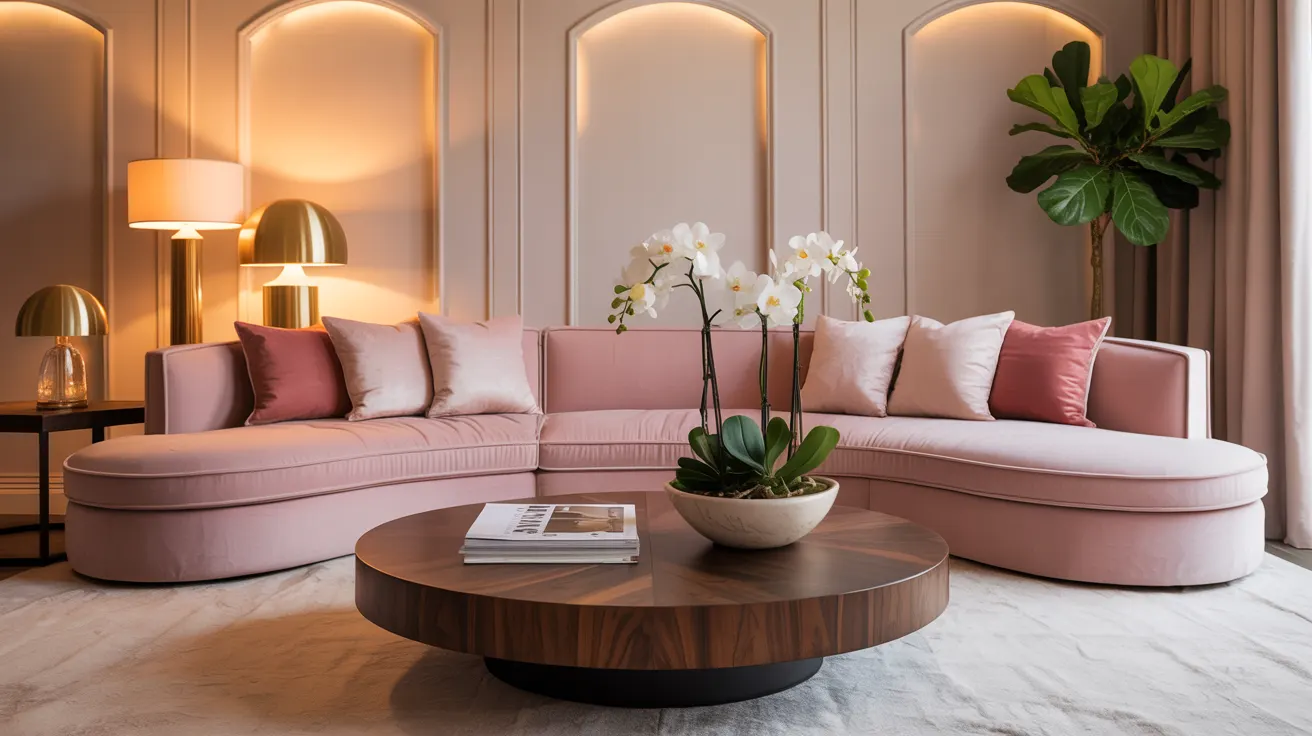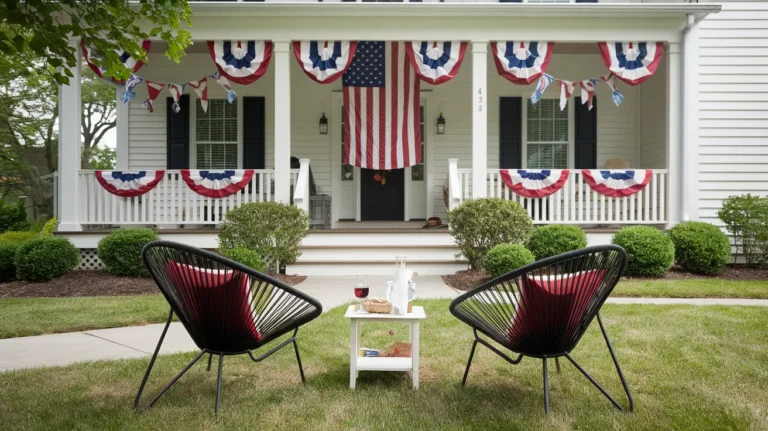Pink gets a bad rap. For too long, it’s been relegated to little girls’ bedrooms and dismissed as childish or overly feminine. But if you’ve been paying attention to design trends lately, you’ll know that pink has undergone a major glow-up.
Today’s pink living rooms aren’t saccharine or juvenile—they’re sophisticated, versatile, and incredibly stylish. From the softest blush that almost reads as a neutral to bold magenta that makes a definitive statement, pink has proven itself as a legitimate contender in grown-up spaces.
I’ve been slightly obsessed with pink interiors lately (my Pinterest boards don’t lie), and I’m here to show you how this versatile color can transform your living room into something truly special. Let’s explore some genuinely gorgeous pink living room ideas that might just convert even the most skeptical among you.

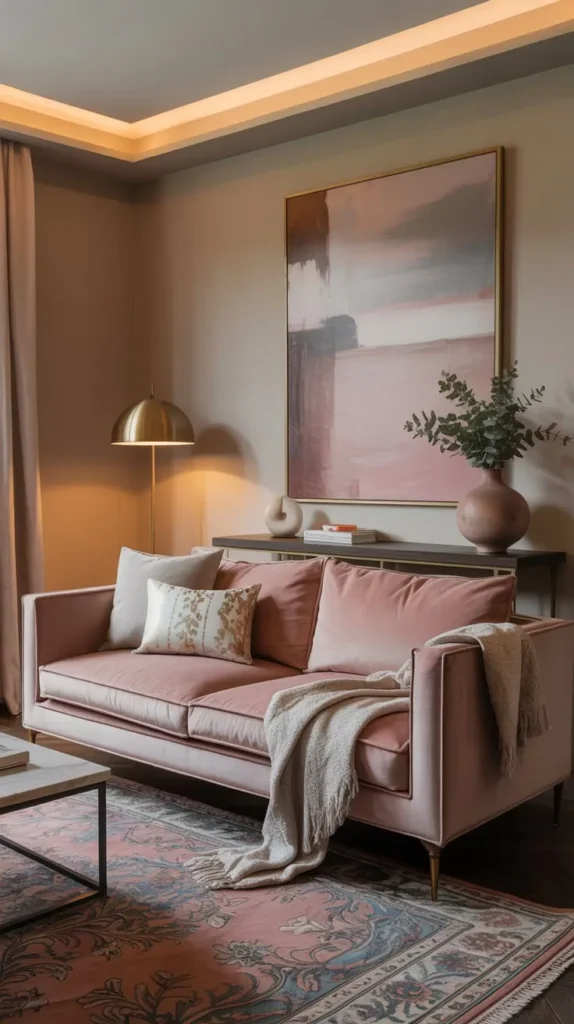
Why Pink Deserves a Place in Your Living Room
Before we dive into specific styles, let’s talk about why pink works so beautifully in living rooms. Unlike some colors that can feel too energetic (looking at you, bright red) or too cold (hello, certain blues), pink strikes a remarkable balance.
Pink living rooms offer:
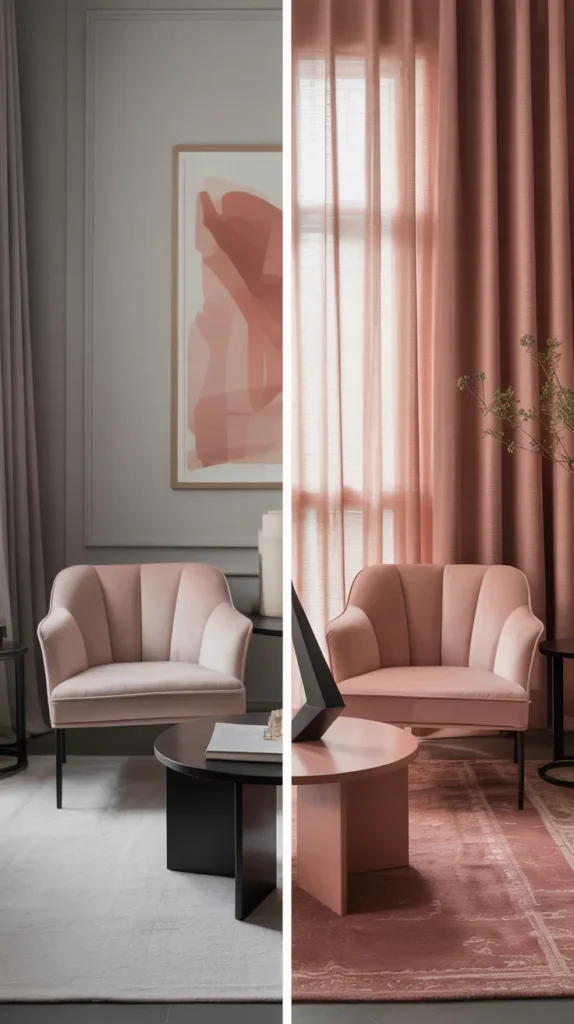
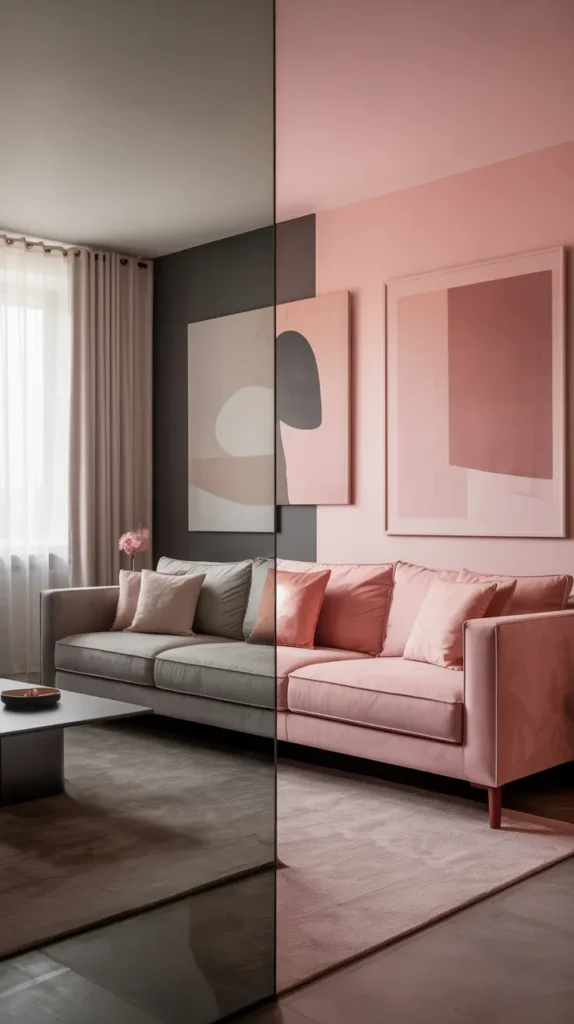
- Warmth without heaviness – Pink adds coziness without darkening your space
- Versatility across design styles – From minimalist to maximalist, pink adapts beautifully
- Unexpected sophistication – The right pink elevates a space in surprising ways
- Psychological benefits – Soft pinks can be calming and create a sense of nurturing
I’ve found that pink has an almost magical quality in living spaces. It flatters every skin tone (making everyone look good when they’re in your living room), it plays well with nearly every other color, and it can make a space feel special without being overwhelming.
Finding Your Perfect Pink: From Barely-There to Bold
The beauty of decorating with pink is the incredible range this color offers. “Pink” isn’t just one color—it’s a whole spectrum of possibilities.
Some pinks to consider for your living space:
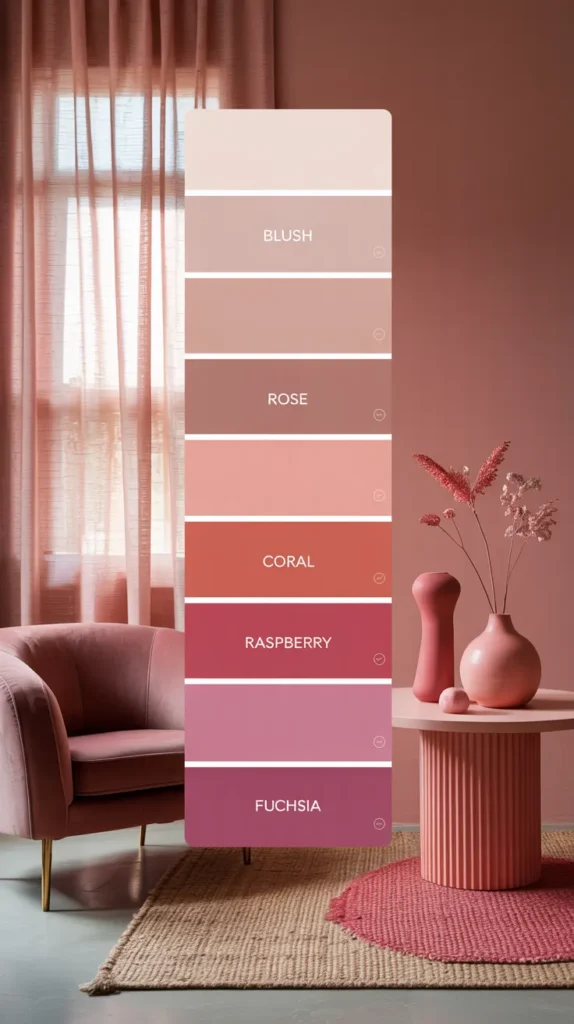
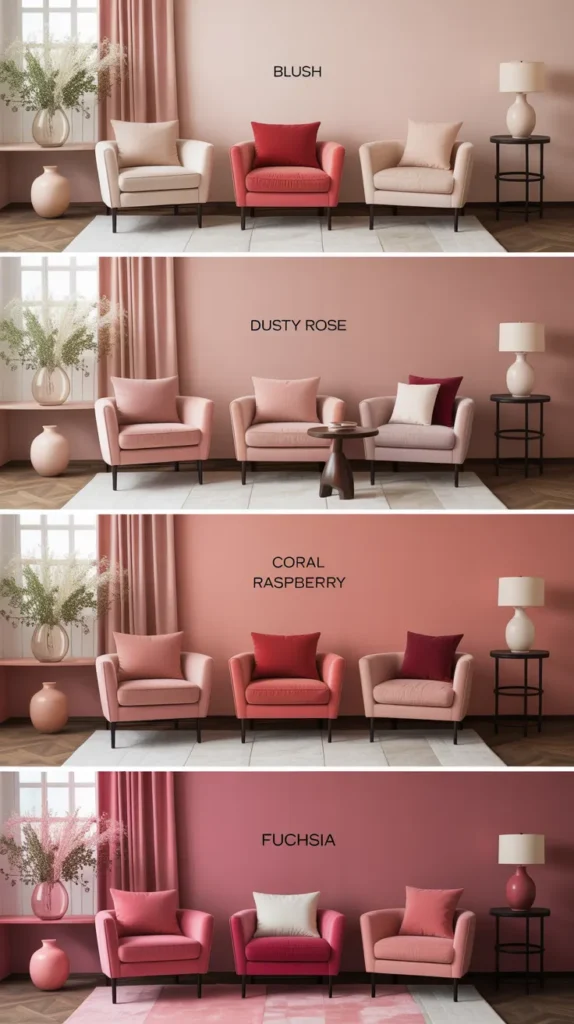
- Blush – So subtle it almost reads as a neutral
- Dusty rose – A sophisticated, muted tone with gray undertones
- Coral – Energetic and warm with orange undertones
- Salmon – A mature pink with depth and complexity
- Fuchsia – Bold, vibrant, and statement-making
- Raspberry – Rich and sophisticated with hints of purple
The key is finding the right pink for your space and preferences. If you’re color-shy, start with blush tones that function almost like neutrals. If you’re more adventurous, consider deeper or brighter pinks as accent colors or even for larger elements like a sofa or accent wall.
Pro tip: The undertones in your pink matter tremendously. Pinks with gray or beige undertones (sometimes called “dirty pinks”) tend to feel more sophisticated and grown-up than clearer, brighter pinks.
Pink Modern Boho: Free-Spirited Elegance
Bohemian style and pink are a natural pairing—both embrace expressiveness, warmth, and a certain free-spirited quality. But modern boho adds a contemporary edge that keeps things from feeling too hippie-dippy.
In a pink modern boho living room, look for:
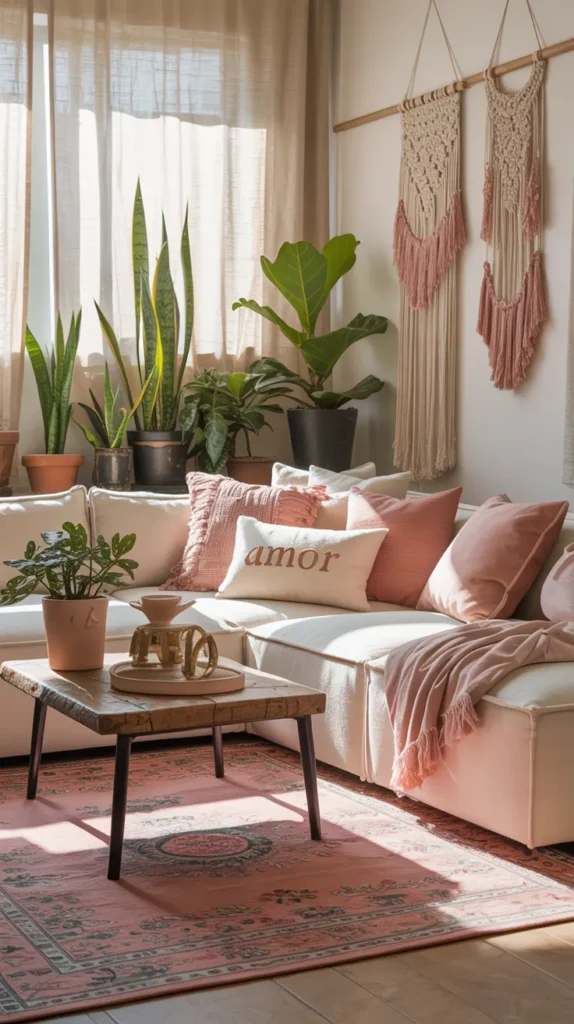
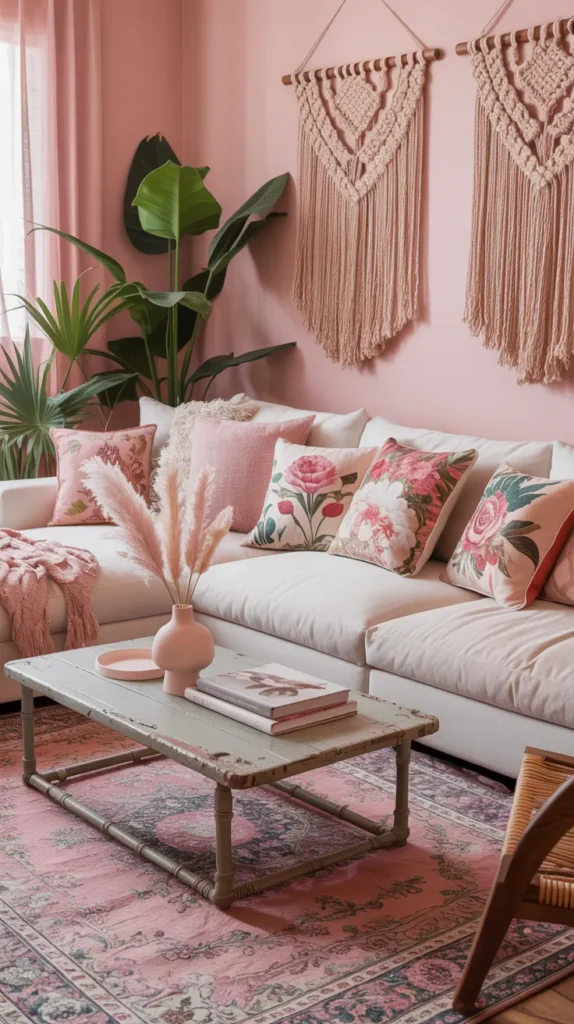
- A mix of textures and patterns featuring different shades of pink
- Natural materials like rattan, jute, and unfinished woods
- Layered textiles with global influences
- Plants to add life and contrast to the pink elements
- A balance of vintage and contemporary pieces
What I love about pink modern boho spaces is their effortless, collected-over-time feel. Nothing looks too perfect or coordinated. A faded pink vintage rug might sit beneath a contemporary sofa with blush pillows, while macramé wall hangings and plants add natural texture and interest.
For those worried about pink feeling too precious, the casual nature of boho style helps counterbalance this perception. The result is a space that feels both feminine and grounded, artistic and livable.
Pink Parisian: Timeless Sophistication
If there’s one design style that knows how to handle pink with grown-up sophistication, it’s Parisian. French design has long embraced pink—from the palest blush to rich raspberry—treating it with the respect it deserves.
A pink Parisian-inspired living room typically features:
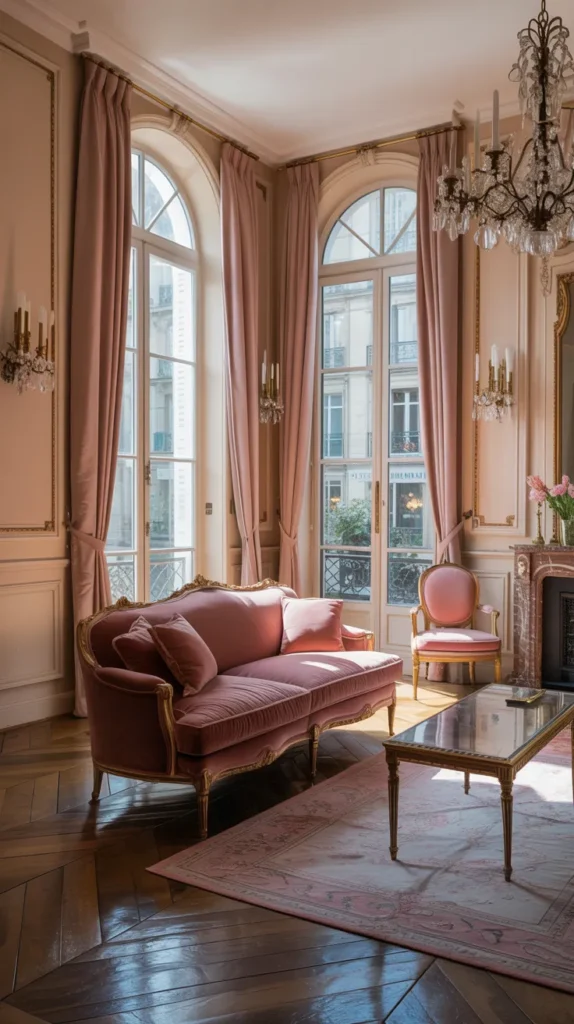
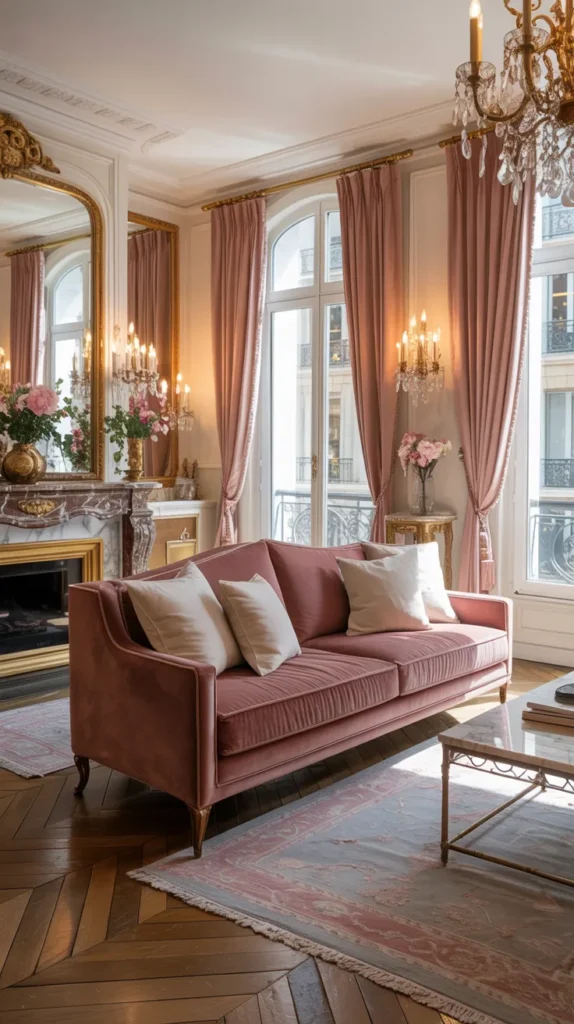
- Architectural details like crown molding and herringbone floors
- A mix of old and new—perhaps an ornate vintage mirror above a modern sofa
- Refined textiles like velvet and silk in carefully chosen pink tones
- Gold or brass accents that add warmth and elegance
- Art as a focal point, often framed in gold
The Parisian approach to pink is never childish or overly sweet. Instead, it’s confident and sophisticated. Think of a dusty rose velvet sofa paired with cream walls, gold-framed art, and perhaps a vintage Persian rug with hints of pink running through it.
I’m particularly fond of how Parisian style uses pink as a deliberate choice rather than an afterthought. It’s not about sprinkling in a few pink accessories—it’s about making a statement with a beautifully upholstered pink chaise or a set of floor-to-ceiling pink silk drapes.
Pink Maximalist: Bold, Dramatic, and Utterly Fabulous
If subtle isn’t in your vocabulary, pink maximalist might be your perfect match. This approach embraces the “more is more” philosophy with enthusiasm and creates spaces that are dramatic, playful, and full of personality.
A pink maximalist living room celebrates:
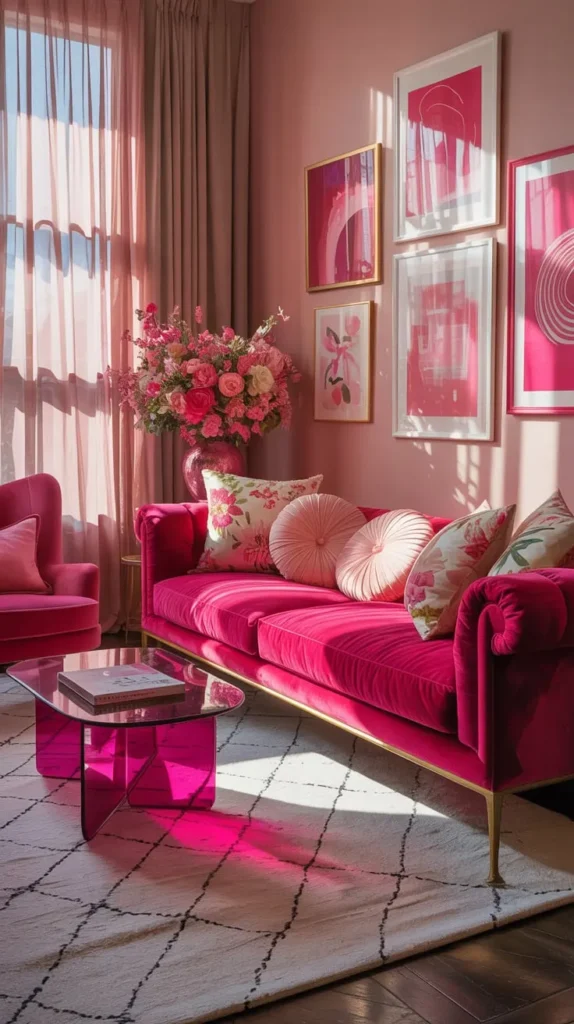
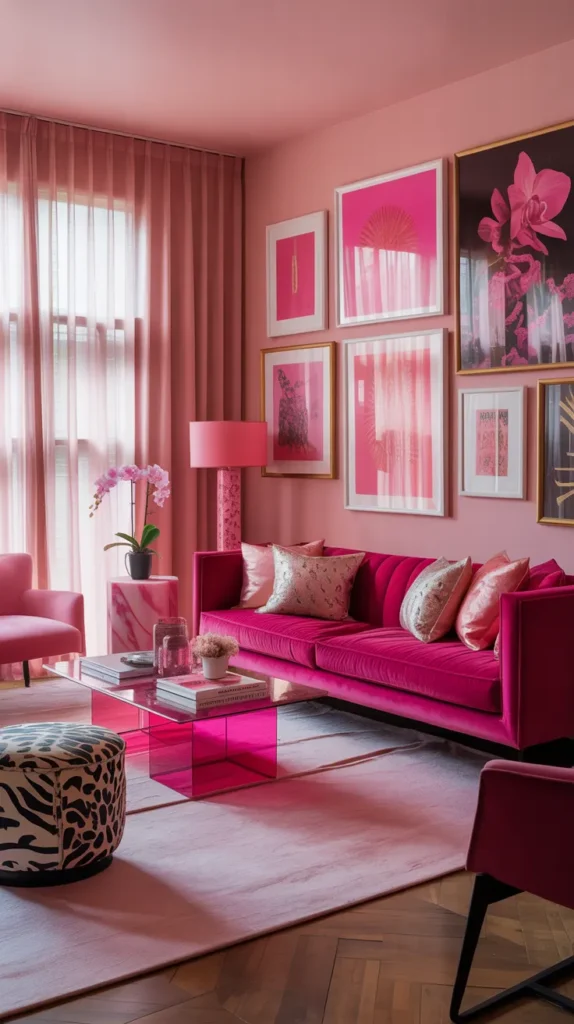
- Multiple shades of pink used together confidently
- Pattern mixing—florals, geometrics, animal prints all in pink tones
- Statement furniture like a hot pink velvet sofa or fuchsia armchairs
- Gallery walls that incorporate pink throughout
- The mixing of different design styles and eras
What saves pink maximalist spaces from feeling chaotic is the cohesion that comes from the color story. When everything relates back to various shades of pink, even the most eclectic collection of items feels intentional rather than random.
I’ve noticed that the most successful pink maximalist spaces maintain a sense of editing—everything feels chosen with purpose, even if there’s a lot of it. It’s abundant and exuberant, but not messy or haphazard.
Pink Scandinavian: Subtle Warmth Meets Minimalist Cool
Scandinavian design is known for its restraint and emphasis on light, so pink adds a welcome touch of warmth and personality without undermining the style’s clean, minimal nature.
In a pink Scandinavian living room, you’ll find:
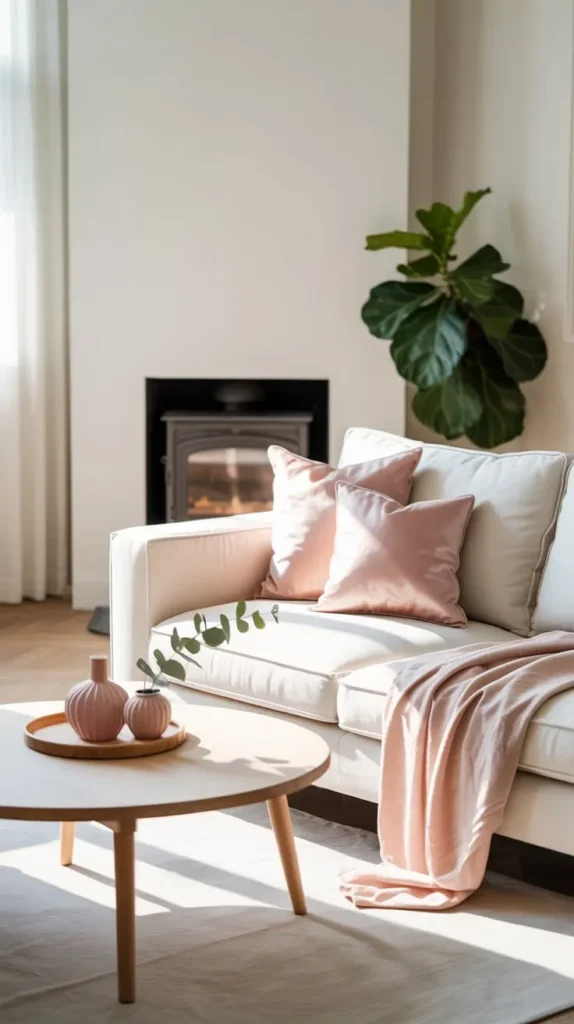
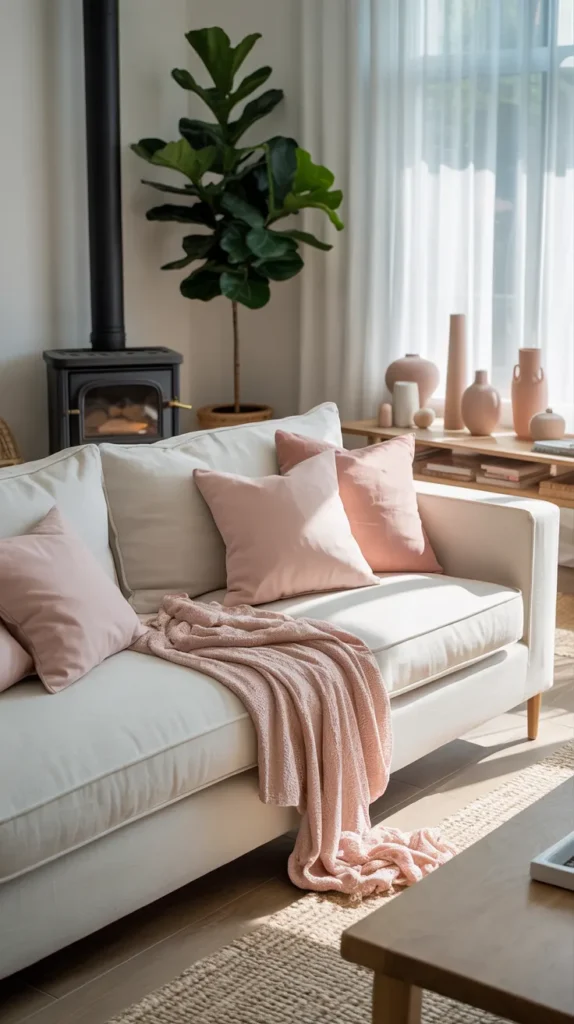
- A predominantly white or light gray backdrop
- Pale pink as an accent color used sparingly but effectively
- Natural wood elements that balance the softness of pink
- Minimal patterns, perhaps a simple geometric in soft pink
- Plenty of negative space to let the design elements breathe
What works so beautifully about this combination is how the addition of pink softens the potential starkness of Scandinavian design. A pure white and wood Scandi space can sometimes feel a bit cold or austere. Add touches of pale pink in a throw blanket, a few cushions, or a simple vase, and suddenly the space feels more inviting and lived-in.
This approach is perfect for those who are pink-curious but not ready to commit to larger doses of the color. The restrained use keeps things firmly in sophisticated territory while still allowing you to experiment with this versatile hue.
Modern Pink: Clean Lines Meet Warm Tones
Modern design with its emphasis on clean lines and uncluttered spaces creates the perfect canvas for pink to shine. The contemporary setting keeps pink from feeling too traditional or fussy.
A modern pink living room typically features:
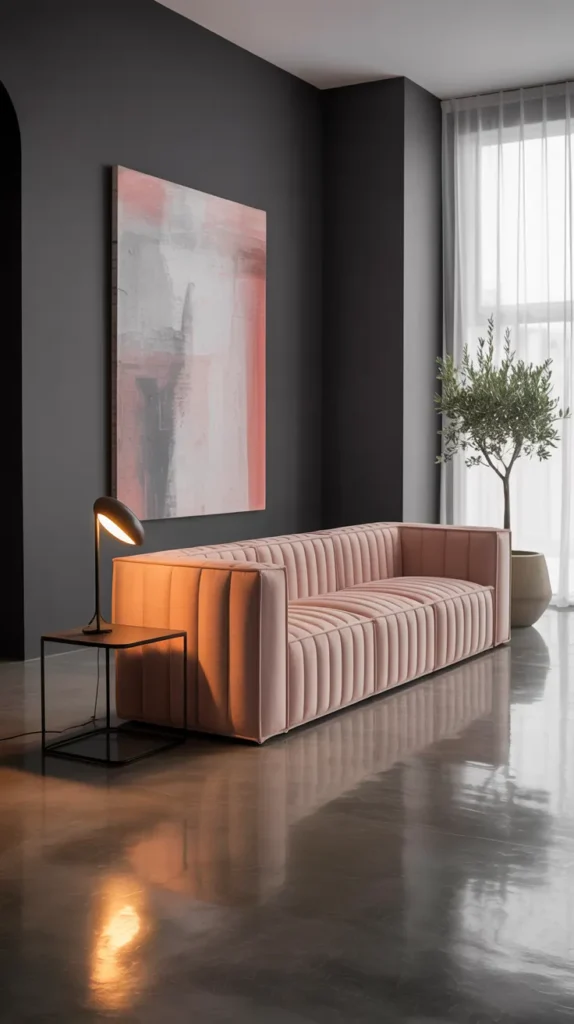
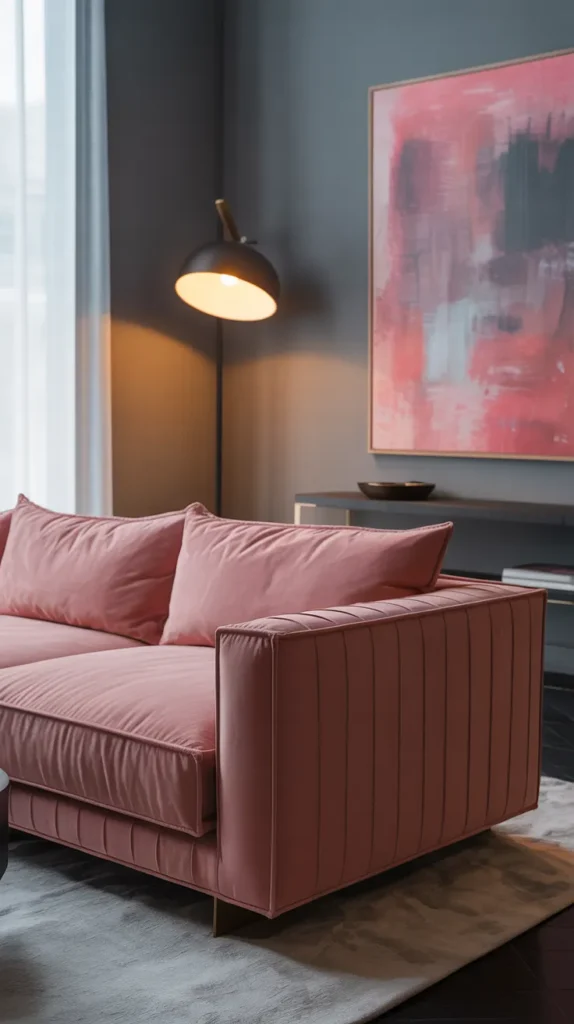
- Architectural furniture with simple, clean lines
- Strategic use of pink in both small and large elements
- Unexpected combinations like pink with black or charcoal gray
- Thoughtful lighting that highlights the pink elements
- A restrained palette with pink as one of just a few colors
I particularly love how modern spaces can handle bolder pinks without feeling overwhelming. A streamlined modern sofa in raspberry velvet becomes a stunning focal point when placed in a minimal space with white walls and concrete floors. The simplicity of the surroundings allows the pink to be appreciated as a deliberate design choice rather than a decorative afterthought.
For those concerned about pink feeling too feminine, modern design elements provide the perfect counterbalance. The juxtaposition of a soft color with strong architectural lines creates an intriguing tension that keeps things interesting.
Pink Japandi: Serene Minimalism With a Touch of Warmth
Japandi style—the beautiful fusion of Japanese and Scandinavian design—creates spaces that feel both minimal and warm. The addition of pink, used thoughtfully, enhances this quality of serene comfort.
In a pink Japandi living room, look for:
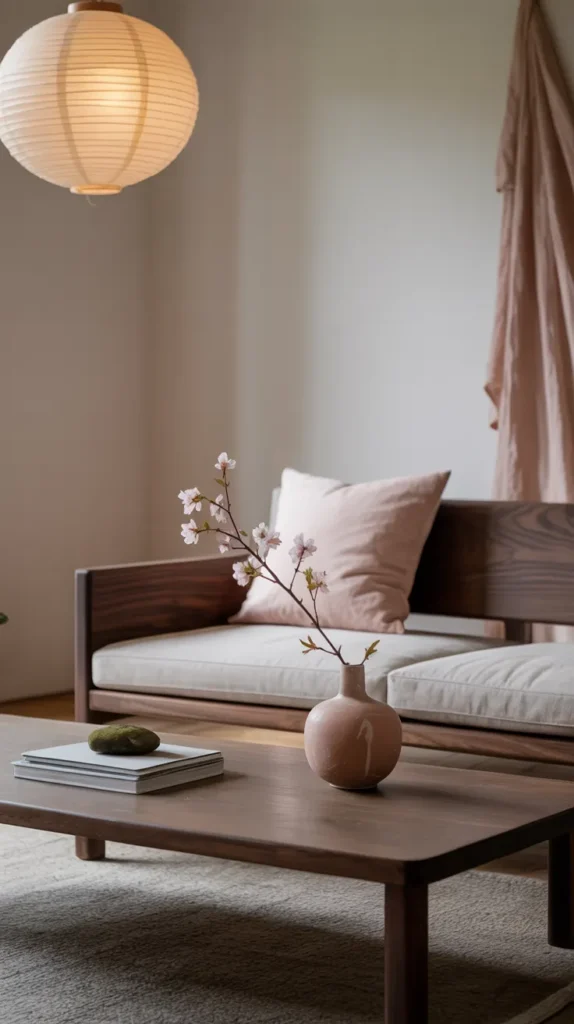
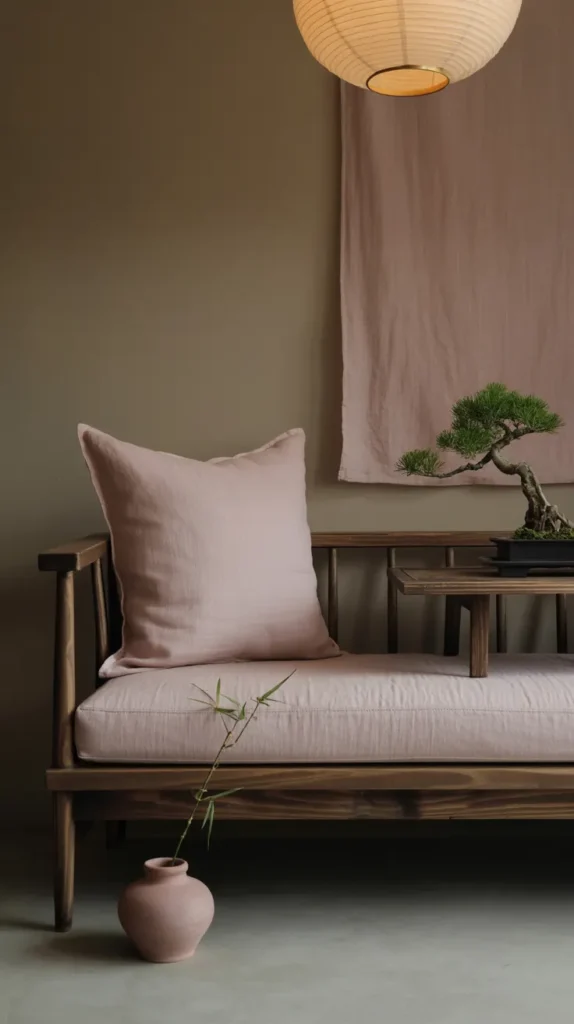
- A limited palette featuring subtle pink tones alongside neutrals
- Natural materials with minimal processing
- Clean lines and purposeful negative space
- Handcrafted elements that add character and authenticity
- A sense of harmony and balance throughout the space
What makes pink work so well in Japandi interiors is how it can soften the minimalism without undermining it. A pale pink linen throw pillow on a low wooden sofa, or a handmade ceramic in dusty rose—these small touches add dimension and interest while maintaining the essential calm of Japandi design.
I find this combination particularly effective in creating spaces that feel both design-forward and genuinely livable. The restraint of Japandi keeps pink feeling sophisticated and intentional, while the pink adds a touch of approachable warmth to what could otherwise feel austere.
Making Pink Work: Practical Tips for Any Style
No matter which pink living room style speaks to you, here are some practical tips for incorporating this versatile color successfully:
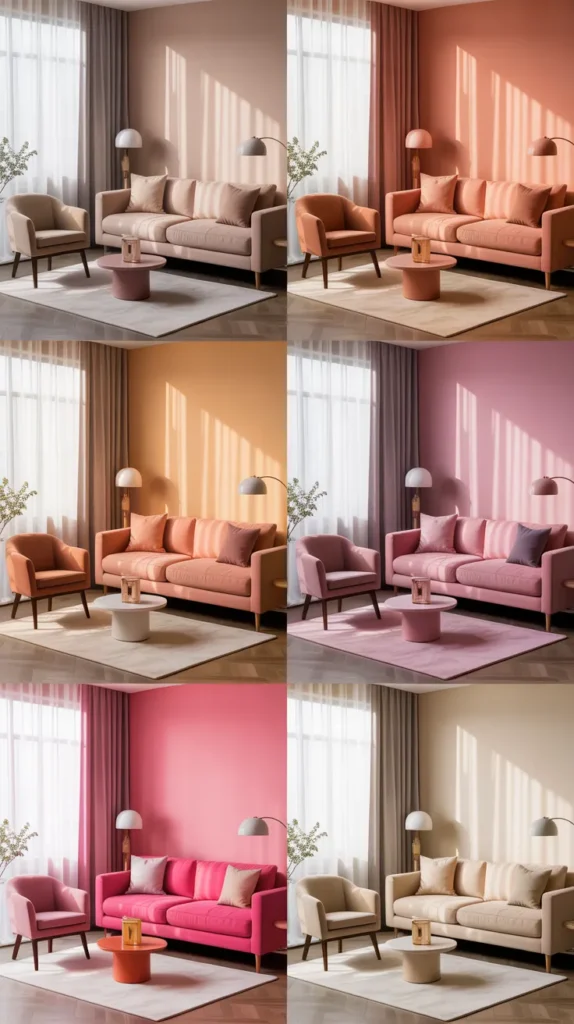
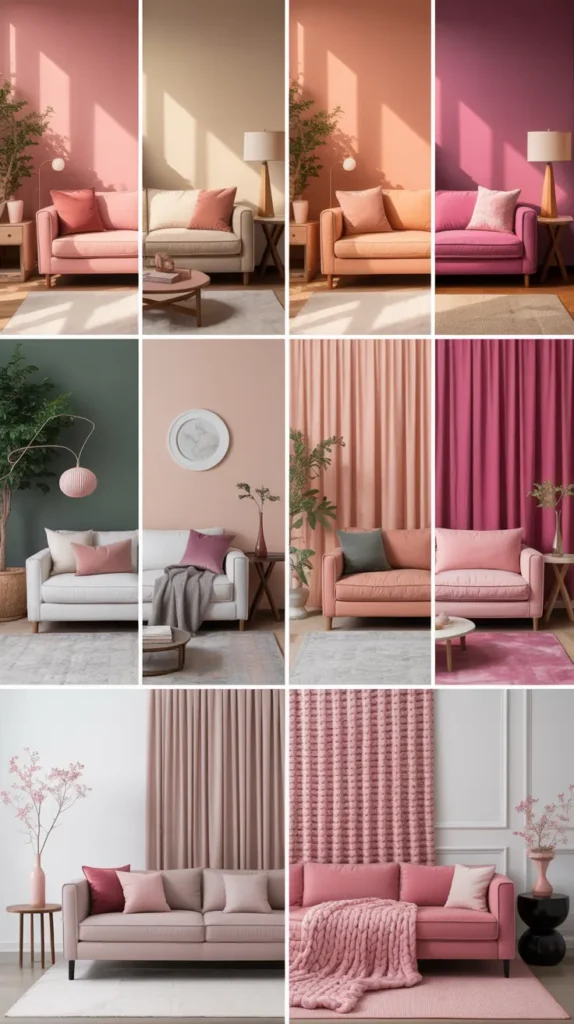
- Consider the light in your space — Pink looks different throughout the day and under different lighting conditions. Test your pink in your actual space before committing.
- Pay attention to undertones — Make sure the undertones in your pink complement the other colors in your space. A pink with peach undertones creates a very different feel than one with purple undertones.
- Balance is key — Unless you’re going full maximalist, balance pink with neutrals or complementary colors to keep it from becoming overwhelming.
- Use different shades — Incorporating various tones of pink adds depth and sophistication compared to flat, one-note pink.
- Think about texture — Pink in different textures (velvet, linen, wool, etc.) adds dimension and interest to your space.
- Start small if you’re uncertain — If you’re not ready for pink walls or furniture, begin with accessories like pillows, throws, or artwork.
The wonderful thing about decorating with pink is that it can be as subtle or as bold as you want it to be. From the barest hint in a few carefully chosen accessories to full-on pink walls and furniture, this versatile color offers options for every comfort level.
Whether you’re pink-curious or already a devoted fan, I hope these ideas have shown you that pink deserves serious consideration for your living space. Far from being just a color for children’s rooms, the right pink in the right setting creates living rooms that are sophisticated, inviting, and undeniably special. ✨

